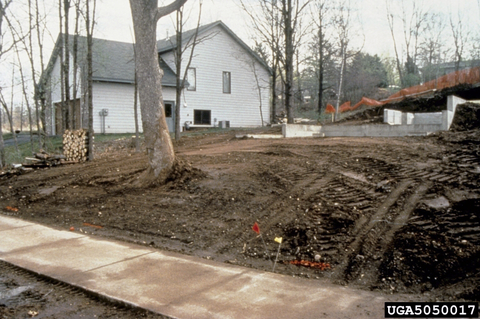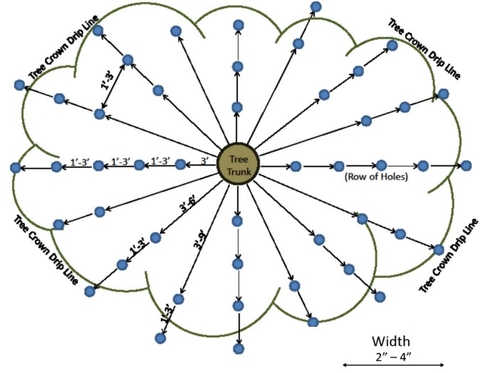Sometimes when I visit an ailing tree, there is not an obvious cause from insects, weather, or disease. The leaves may become yellow or fall off like it was under drought. Growth slows to a crawl and the canopy starts to thin. In these cases, what lies underground is likely the prime suspect. In residential areas, the soil tends to be compacted on the surface from foot traffic or vehicles driving over the yard. It can also become compacted much deeper from when the home was first built.
A young tree might start off OK, but once the roots hit compacted zones, they can become sick. Improving the soil takes time—time that a tree may not have. For compaction, it is far better to prevent or adapt rather than fix.
If you know you have a troublesome spot, choose trees and bushes that can tolerate clay or compacted soils. If a site is difficult enough, you may want to switch over to native grasses and forbs. UMN Extension’s publication The Best Plants for 30 Tough Sites is a great resource that can help you plan.
For homeowners looking for a compaction cure with established trees, “vertical mulching” has been a popular topic on garden sites recently.
What is vertical mulching?
In essence, vertical mulching involves digging long, narrow trenches or using an auger to drill holes around the tree. Later, these areas are filled with material. Exactly what you fill these areas with changes every time I see an article about it—sand, gravel, perlite, compost, fertilizers, mulch, or backfilled soil.
This video from Texas A&M Extension shows the benefits of vertical mulching and covers what equipment can be used. The University of Florida also has information on improving compacted soils through vertical mulching. Tree care companies are also sources of YouTube videos.
So what is the reality?
Any benefits from vertical mulching seem to depend on what is used to refill the holes or trenches. The majority of scientific papers agree that the best filling materials to place around the tree are decomposable ones. As they break down, the extra organic matter builds soil structure, which then helps air and water movement. Often, these materials take the form of compost, sawdust or mulch. Backfilled soil appeared to work OK as a substitute as well.
In contrast, evidence is NOT good for filling the holes with inorganic things such as perlite, gravel, or sand. A 1994 University of Kentucky experiment found roots may have actively avoided perlite-filled zones.
When big texture differences occur in the soil—like an even layer of clay over gravel—water tends to accumulate at the boundary where they meet. Saturated areas prevent roots from getting oxygen, and the plant is “smart” enough to avoid this if it is able.
The idea of vertical mulching is similar to core aeration in lawns, where soil plugs are pulled out of the ground to reduce compaction or prevent excessive thatch. Fertilizer or seeds can also be added as a part of this aeration process.
Of course, turfgrass is not the same as a tree. No one will miss an individual grass plant if an aerator pulls its root system from the ground. In contrast, trees often have a big monetary or sentimental value attached to them. Vertically mulching too close to the trunk could mean serious damage if the auger or shovel accidentally hits a major root.
Surface vs. vertical mulching
What can you do to cure compaction aside from vertical mulching? Applying biodegradable mulches and compost to the surface could offer the same benefits without the risk and extra work.
A 2009 University of Georgia study found that surface mulching and vertical mulching had similar effects on the soil after three years. A newer 2011 paper from Clemson University concluded surface mulching was even superior.
So if you do decide to apply mulch to the surface, do it correctly. For established trees, UMN Extension recommends a 3-inch deep mulch that is 12-18 inches away from the trunk and at least 6 feet across. Make sure the tree is adequately watered, and apply fertilizer based on a soil test’s recommendation.
If you decide to vertically mulch instead, use decomposable soil amendments as fill material, and take care when you drill or dig.
- Fite, Kelby, et al. "Evaluation of a soil decompaction and amendment process for urban trees." Arboriculture and Urban Forestry 37.6 (2011): 293.
- Kalisz, P. J., J. W. Stringer, and R. J. Wells. "Vertical mulching of trees: Effects on roots and water status." Journal of arboriculture 20.3 (1994): 141-145.
- Morris, L. A., et al. "Soil compaction and response to amelioration treatments around established trees in an urban campus environment." Proceedings of the 2009 Georgia Water Resources Conference, held April 27–29, 2009, at the University of Georgia
- Texas A&M Forest Service. (2015). “Technical Tree Solutions: Vertical Mulching/Composting”.
- Watson, G., Kelsey, P., & Woodtli, K. (1996). “Replacing soil in the root zone of mature trees for better growth.” Journal of Arboriculture, 22(4), 167-172.




